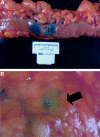Sentinel node staging of resectable colon cancer: results of a multicenter study
- PMID: 15383790
- PMCID: PMC1356464
- DOI: 10.1097/01.sla.0000140753.41357.20
Sentinel node staging of resectable colon cancer: results of a multicenter study
Abstract
Objective and summary background data: Sentinel lymph node (LN) sampling, a technique widely used to manage breast cancer and melanoma, seeks to select LNs that accurately predict regional node status and can be extensively examined to identify nodal metastatic disease not detected by standard histopathological staging. For patients with resectable colon cancer, improved identification of LN disease would significantly advance patient care by identifying patients likely to benefit from adjuvant therapy. This study, conducted by 25 surgeons at 13 institutions, examined whether sentinel node (SN) sampling accurately predicted LN status for patients with resectable colon cancer.
Methods: SN sampling involved peritumor injection of 1% isosulfan blue, followed by identification of all LN visualized within 10 minutes. SN sampling was performed on 79 of 91 patients enrolled, followed by multilevel sectioning (MLS) of the nodes and examination by a single study pathologist.
Results: By standard histopathology, 7 patients had primary disease that was either benign or not colon cancer and were therefore excluded from further studies. Of 72 colon cancer cases studied, 48 (66%) were node-negative and 24 (33%) contained nodal metastases. SNs were successfully located in 66 cases (92%), with an average of 2.1 nodes per patient. SNs were negative in 14 of 24 node-positive cases (58%). MLS revealed tumor in a SN in 1 of these cases, bringing the false-negative rate of SN examination to 54%.
Conclusion: This multi-institutional study found that for patients with node-positive colon cancer, SN examination with MLS failed to predict nodal status in 54% of cases. We conclude that SN sampling with MLS, used alone, is unlikely to improve risk stratification for resectable colon cancer.
Figures

References
-
- Jemal A, Tiwari RC, Murray T, et al. Cancer statistics, 2004. CA Cancer J Clin. 2004;54:8–29. - PubMed
-
- Liefers G-J, Cleton-Jansen A-M, van de Velde CJH, et al. Micrometastases and survival in stage II colorectal cancer. N Engl J Med. 1998;339:223–228. - PubMed
-
- Sanchez-Cespedes M, Esteller M, Hibi K, et al. Molecular detection of neoplastic cells in lymph nodes of metastatic colorectal cancer patients predicts recurrence. Clin Cancer Res. 1999;5:2450–2454. - PubMed
Publication types
MeSH terms
Substances
Grants and funding
- U10 CA032291/CA/NCI NIH HHS/United States
- CA33601/CA/NCI NIH HHS/United States
- U10 CA077658/CA/NCI NIH HHS/United States
- CA77406/CA/NCI NIH HHS/United States
- CA32291/CA/NCI NIH HHS/United States
- CA12046/CA/NCI NIH HHS/United States
- U10 CA045418/CA/NCI NIH HHS/United States
- CA77440/CA/NCI NIH HHS/United States
- CA04326/CA/NCI NIH HHS/United States
- CA21060/CA/NCI NIH HHS/United States
- CA47642/CA/NCI NIH HHS/United States
- CA45418/CA/NCI NIH HHS/United States
- CA77658/CA/NCI NIH HHS/United States
- CA37135/CA/NCI NIH HHS/United States
- CA77298/CA/NCI NIH HHS/United States
- U10 CA047642/CA/NCI NIH HHS/United States
- CA31946/CA/NCI NIH HHS/United States
- U10 CA033601/CA/NCI NIH HHS/United States
- U10 CA021060/CA/NCI NIH HHS/United States
- U10 CA077440/CA/NCI NIH HHS/United States
- CA59594/CA/NCI NIH HHS/United States
LinkOut - more resources
Full Text Sources
Other Literature Sources

